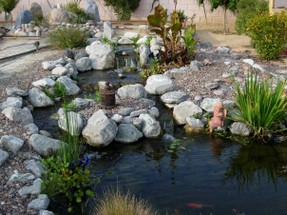Posted by Blue Thumb on Aug 1st 2022
How to Choose the Right Pond Pump for Your Outdoor Water Feature
Introduction
Pumps are essential to any outdoor water feature and come in many shapes and sizes. Before you buy, you must understand the different options available to make an informed decision. For example, direct drive pumps are great for high-flow applications but are not ideal for smaller applications because of energy costs.
Pond pumps in a nutshell
Pond pumps are essential to your water feature and significantly impact your pond's overall look and function.
Pond pumps will help you move water around your pond so it can be circulated into different areas. They're available in a wide range of styles, sizes, and power ratings, so it's important to know what you're looking for before you make your purchase.
When choosing the right pump for your outdoor water feature:
Consider what you need the pump for
When pond pumps are mentioned, it's easy to think of them as one-size-fits-all. But there are many different types of pumps for water fountains, ponds, and cascades, reflecting the variety in pump usage.
Before you select a pond pump for your outdoor water feature, you should consider what you need the pump for. First and foremost:
- Consider the size of your pond or fountain. This is simply a matter of measuring the surface area and depth (in feet) and then finding a corresponding sized pump for the volume of water you need to turnover.
- Consider the flow rate that you need. The flow rate is how much water will pass through an opening per minute/hour. If your fountain has large spaces or if it's tall, then high flow rates will be necessary for effective operation downstream from where this happens inside its system; meanwhile, low flow rates may be sufficient if only small amounts of water are flowing through its pipes at any given time during use—such as when misting without any specific directionality involved anywhere within those pipes.
Three basic types are magnetic drive pumps, hybrid or asynchronous, and direct drive pumps. Each type has advantages depending on what kind(s) work best with different water feature applications.
Magnetic Drive Pumps
One of the most popular types of water pumps is the magnetic drive pump. Magnetic drive pumps are best for applications where the water flow is not too high, like a small waterfall or fountain. They're also quieter than other types of pumps, making them ideal if you plan on having your outdoor feature near your living space.
Magnetic drive pumps use magnets to circulate an impeller that creates pressure to draw water through its intake and discharge ports. These are usually long-lived; generally, only a new impeller is needed to refresh the pump. These pumps are best used in small water gardens or fountain applications.
Hybrid or Asynchronous Pumps
Hybrid or asynchronous motors are a more recent development in pond pumps. They can perform like direct drives but are energy efficient like mag-drives. Hybrid pumps like the Blue Thumb Ilumiflow are highly reliable and can be found in many applications that use high head heights above the water level. These pumps are best used on ponds with lower head heights, less than 25 feet (7 m). The most common uses for these pumps are medium to large-sized ponds/waterfalls.
Direct Drive Pumps
A direct drive pump is the most powerful type of pond pump. It's more expensive, but you pay for the power and performance you get. A direct drive like Blue Thumb’s Clear Water Pump, Solids Handling Pump, or External Pump will have a slightly higher energy cost than other pumps because it will draw more current at higher speeds to generate higher flows.
Direct drive pumps work best in large ponds requiring high head pressure and flow rate, so the pump can climb vertically before spilling down.
Conclusion
After reading this article, you should understand what to look for when purchasing a pond pump. The most important thing is to decide what kind of use you want, the flow rate you'll need, and how much power it needs to run efficiently. Many different types are available on the market today, so take some time to research!

